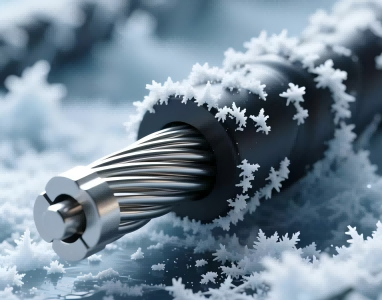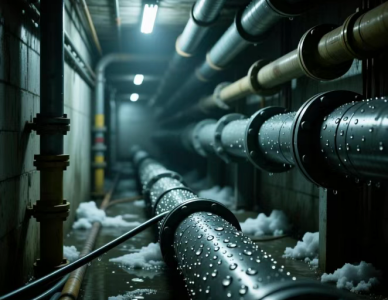In regions covered by ice and snow, the selection of a single cable can impact the safety and stability of the entire power system. In extreme winter environments, standard PVC insulation and PVC sheath cables can become brittle, crack easily, and reduce electrical performance, potentially causing failures or safety hazards. According to the Power Engineering Cable Design Standard, areas with annual minimum temperatures below -15°C require dedicated low-temperature cables, while regions below -25°C need specially designed cold-resistant power cables, armored cables, or steel tape armored cables.
1.Impact of Severe Cold on Cables
Cables in low temperatures face multiple challenges. Low-temperature embrittlement is the most direct problem. Standard PVC-sheathed power cables lose flexibility, crack when bent, and may fail to meet the demands of harsh environments. Insulation materials, especially PVC, may degrade, leading to signal transmission errors or power leakage. Armored cables, including steel tape armored cables, require installation temperatures above -10°C, while non-armored power cables have even stricter requirements. XLPE-insulated cables, PE-sheathed cables, and LSZH-sheathed cables should be preconditioned in a heated environment for at least 24 hours at ≥15°C before installation to maintain optimal performance.
2.Understanding Cable Model Codes
Selecting the right cable starts with understanding its model code, which indicates the cable type, conductor material, insulation, inner sheath, structure, outer sheath, and special properties.
Conductor Materials: Copper cores (“T”) are preferred in cold regions for superior low-temperature conductivity. Aluminum cores are marked “L.”
Insulation Materials: V (PVC), YJ (XLPE), X (Rubber). XLPE (YJ) and rubber-insulated cables have superior low-temperature performance.
Sheath Materials: PVC has low-temperature limits. PE, PUR (polyurethane), PTFE (Teflon), and LSZH sheaths provide better cold resistance for power cables, control cables, and low-voltage cables.
Special Markings: TH (tropical wet), TA (tropical dry), ZR (flame-retardant), NH (fire-resistant) may be relevant. Some armored or control cables may also use Mylar Tape or Aluminum Foil Mylar Tape for separation, shielding, or enhanced mechanical protection.
3.Cable Selection by Temperature
Different cold environments require matching cable materials and construction to prevent system failures:
> -15°C: Standard PVC-sheathed power cables can be used, but installation must be >0°C. Insulation: PVC, PE, XLPE.
> -30°C: Sheath materials should include PE, cold-resistant PVC, or nitrile composite sheaths. Insulation: PE, XLPE. Installation temperature ≥ -10°C.
< -40°C: Sheath materials must be PE, PUR, or PTFE. Insulation: PE, XLPE. Installation temperature ≥ -20°C. Armored cables, steel tape armored cables, and LSZH-sheathed cables are preferred for maximum reliability.
4.Installation and Maintenance
Cold-resistant cable installation requires careful preparation. Preheating cables is essential when temperatures fall below recommended limits: 5–10°C (~3 days), 25°C (~1 day), 40°C (~18 hours). Installation should be completed within 2 hours after leaving heated storage. Handle cables gently, avoid dropping, and reinforce bends, slopes, or tension points. Inspect all cables post-installation, including armored cables, for sheath damage, cracks, or insulation issues. Use Mylar Tape or Aluminum Foil Mylar Tape as needed for shielding or separation in signal and power cables.
5.Comprehensive Considerations
Besides temperature, consider these factors when selecting cold-resistant cables:
Installation Environment: Direct burial, cable trench, or tray affects heat dissipation and mechanical protection. PE, PUR, PTFE, and LSZH sheaths must be matched accordingly.
Power and Signal Requirements: Evaluate voltage rating, current carrying capacity, signal integrity, and interference resistance. Aluminum Foil Mylar Tape may be needed for shielding low-voltage, control, or instrumentation cables.
Flame Retardant and Fire-Resistant Requirements: ZR, NH, and WDZ (low smoke halogen-free) may be required for indoor, tunnel, or enclosed spaces.
Economics and Lifetime: Cold-resistant XLPE, PE, PUR, PTFE, armored, or steel tape armored cables have higher upfront costs but reduce replacement and downtime due to low-temperature damage.
Selecting the right cold-resistant cable materials, including PVC, XLPE, PE, PUR, PTFE, LSZH, armored, and steel tape armored cables, ensures power system reliability, safe operation, and long-term performance in severe winter conditions. Proper cable selection is crucial not only for power stability but also for overall electrical safety.
Post time: Nov-21-2025



